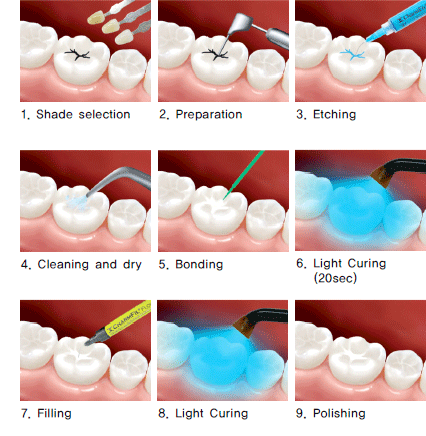Fissure Sealants and Preventive Resin Restorations
Protecting your teeth, preventing decay
Our teeth are constantly being covered with a sticky film of bacteria called plaque. When we eat or drink anything that contains sugar – such as cookies, candy, soda, juice, fruit, milk and many other foods and beverages – bacteria turn the sugar into acids that can attack tooth enamel.

Over time repeated attacks may result in decay. The good news is that there is a way to protect your teeth and prevent decay: dental sealants.
Tooth decay often occurs on the chewing surfaces of the back teeth. These surfaces have pits and grooves (fissures) that trap plaque, bacteria and bits of food.
The pits and fissures are hard to keep clean, because toothbrush bristles cannot reach into them. That is how decay starts in the grooves and a cavity forms.
Toothbrush unable to clean the pits and fissures of a tooth

How do sealants work?
To keep decay from starting in the grooves of your back teeth, your dentist may recommend dental sealants. A dental sealant is a plastic material that is applied to a chewing surface of a back tooth. The sealant material flows into the pits and fissures in the teeth. The sealant acts as a barrier, protecting enamel by ‘sealing out’ plaque and food.

Tooth before and after sealing with fissure sealant
How are sealants applied?
Sealants are easy to apply and it takes only a few minutes to seal each tooth. First the teeth to be sealed are cleaned and prepared to help the sealant stick to the tooth. The sealant is then ‘painted’ onto the tooth and a special blue curing light is then used to harden the sealant. Sealants are generally clear or white and cannot be seen when you smile or talk.

Application of fissure sealant
How long do sealants last?
Sealants may last several years before they wear out. They hold up well with everyday chewing but chewing on hard foods, like hard candies, can break down sealants. Sometimes the sealants become worn away or may come off, and the tooth loses its protection. At that time they must be replaced. Your dentist will check the condition of the sealants during your regular dental visits and reapply them as necessary.
Are sealants just for kids?
No. The chance of developing pit and fissure decay begins as soon as the back teeth erupt so children and teenagers are obvious candidates. But adults can also be at risk of this type of decay and can benefit from sealants as well.
Preventive Resin Restorations (PRR)
A PRR is a shallow filling for a cavity that has barely begun. A PRR repairs the damage that has already been done to the tooth. It also protects the tooth from further decay.

Think of a PRR as a thicker, stronger version of a dental sealant. A sealant is a protective covering for a decay-free tooth. A PRR is used to stop early decay when it is too late for a sealant, but a regular filling is not needed yet. The PRR acts as a combination of a filling and a sealant.
Why is a PRR needed?
Once tooth decay starts it must be treated before it gets worse. An abscess from a cavity can cause serious or even life-threatening infections when not properly treated.
A PRR prevents early decay from going deeper into the tooth’s pits and fissures. A PRR can block food and cavity-causing bacteria from getting into these grooves. It can also help lessen the need for bigger fillings and more expensive treatment. It is much simpler and more affordable to treat early decay than to fix a badly decayed tooth.

Early decay is seen as dark areas in the pits and fissures
Who can get a PRR?
PRRs are usually applied to permanent teeth in children or adults when these teeth have very mild and early decay. PRRs are often used on molars as the deep grooves in molars are prone to decay and need extra protection.
If enamel decay is not treated the decay can spread more deeply into the dentine and then the root canal. PRRs can be used to protect the tooth from the progression of the decay.
How are PRRs applied?
The diagram shows the easy stages involved in applying a PRR to a molar tooth

Figure A: Early decay is present in a molar
Figure B: shows the tooth with a PRR

When do they need to be replaced?
Your dentist will check your PRR at every dental visit to make sure its edges are sealed. Your PRR may need to be replaced every few years.
Fissure Sealants and Preventive Resin Restorations are not an alternative to tooth brushing but they can provide added protection against tooth decay. It is very important to maintain a good oral hygiene regime and keep up regular dental check-ups to help prevent dental disease.

How to find us
Modern Dentistry
Level 1 City Walk Centre
City Walk
Civic
Canberra
ACT 2601
Above King O'Malleys Pub
Work: 02 6247 8400
Opening Hours
Modern Dentistry
Monday - 8:30 am - 5:30 pm
Tuesday - 8:30 am - 5:00 pm
Wednesday - 8:30 pm - 5:30 pm
Thursday - 8:30 am - 5:30 pm
Friday - 8:00 am - 3:30 pm
Saturday - Closed
Sunday - Closed
